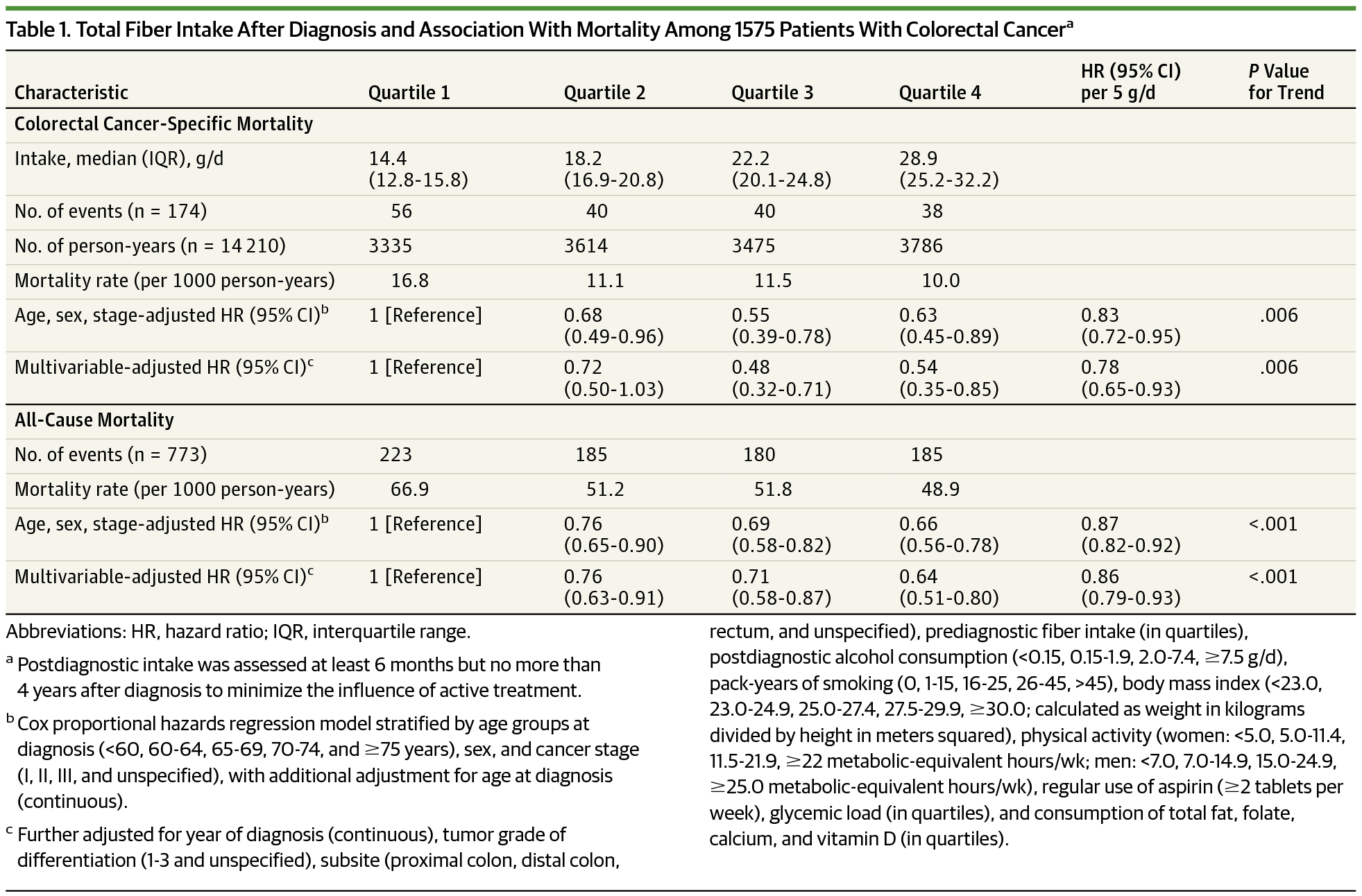当前位置:
X-MOL 学术
›
JAMA Oncol.
›
论文详情
Our official English website, www.x-mol.net, welcomes your
feedback! (Note: you will need to create a separate account there.)
Fiber Intake and Survival After Colorectal Cancer Diagnosis.
JAMA Oncology ( IF 22.5 ) Pub Date : 2018-01-01 , DOI: 10.1001/jamaoncol.2017.3684 Mingyang Song 1, 2, 3 , Kana Wu 3 , Jeffrey A Meyerhardt 4 , Shuji Ogino 4, 5, 6 , Molin Wang 5, 7 , Charles S Fuchs 8, 9, 10 , Edward L Giovannucci 3, 5, 11 , Andrew T Chan 1, 2, 11, 12
JAMA Oncology ( IF 22.5 ) Pub Date : 2018-01-01 , DOI: 10.1001/jamaoncol.2017.3684 Mingyang Song 1, 2, 3 , Kana Wu 3 , Jeffrey A Meyerhardt 4 , Shuji Ogino 4, 5, 6 , Molin Wang 5, 7 , Charles S Fuchs 8, 9, 10 , Edward L Giovannucci 3, 5, 11 , Andrew T Chan 1, 2, 11, 12
Affiliation

|
Importance
Although high dietary fiber intake has been associated with a lower risk of colorectal cancer (CRC), it remains unknown whether fiber benefits CRC survivors.
Objective
To assess the association of postdiagnostic fiber intake with mortality.
Design, Setting, and Participants
A total of 1575 health care professionals with stage I to III CRC were evaluated in 2 prospective cohorts, Nurses' Health Study and Health Professionals Follow-up Study. Colorectal cancer-specific and overall mortality were determined after adjusting for other potential predictors for cancer survival. The study was conducted from December 23, 2016, to August 23, 2017.
Exposures
Consumption of total fiber and different sources of fiber and whole grains assessed by a validated food frequency questionnaire between 6 months and 4 years after CRC diagnosis.
Main Outcomes and Measures
Hazard ratios (HRs) and 95% CIs of CRC-specific and overall mortality after adjusting for other potential predictors for cancer survival.
Results
Of the 1575 participants, 963 (61.1%) were women; mean (SD) age was 68.6 (8.9) years. During a median of 8 years of follow-up, 773 deaths were documented, including 174 from CRC. High intake of total fiber after diagnosis was associated with lower mortality. The multivariable HR per each 5-g increment in intake per day was 0.78 (95% CI, 0.65-0.93; P = .006) for CRC-specific mortality and 0.86 (95% CI, 0.79-0.93; P < .001) for all-cause mortality. Patients who increased their fiber intake after diagnosis from levels before diagnosis had a lower mortality, and each 5-g/d increase in intake was associated with 18% lower CRC-specific mortality (95% CI, 7%-28%; P = .002) and 14% lower all-cause mortality (95% CI, 8%-19%; P < .001). According to the source of fiber, cereal fiber was associated with lower CRC-specific mortality (HR per 5-g/d increment, 0.67; 95% CI, 0.50-0.90; P = .007) and all-cause mortality (HR, 0.78; 95% CI, 0.68-0.90; P < .001); vegetable fiber was associated with lower all-cause mortality (HR, 0.83; 95% CI, 0.72-0.96; P = .009) but not CRC-specific mortality (HR, 0.82; 95% CI, 0.60-1.13; P = .22); no association was found for fruit fiber. Whole grain intake was associated with lower CRC-specific mortality (HR per 20-g/d increment, 0.72; 95% CI, 0.59-0.88; P = .002), and this beneficial association was attenuated after adjusting for fiber intake (HR, 0.77; 95% CI, 0.62-0.96; P = .02).
Conclusions and Relevance
Higher fiber intake after the diagnosis of nonmetastatic CRC is associated with lower CRC-specific and overall mortality. Increasing fiber consumption after diagnosis may confer additional benefits to patients with CRC.
中文翻译:

结直肠癌诊断后的纤维摄入和生存。
重要性 尽管高膳食纤维摄入量与结直肠癌 (CRC) 风险降低有关,但纤维是否有益于 CRC 幸存者仍不清楚。目的评估诊断后纤维摄入量与死亡率的关系。设计、设置和参与者 在 2 个前瞻性队列(护士健康研究和卫生专业人员随访研究)中评估了 1575 名 I 至 III 期 CRC 的医疗保健专业人员。在调整了癌症存活的其他潜在预测因子后,确定了结直肠癌特异性死亡率和总死亡率。该研究于 2016 年 12 月 23 日至 2017 年 8 月 23 日进行。暴露在 CRC 诊断后 6 个月至 4 年期间,通过经过验证的食物频率问卷评估总纤维和不同来源的纤维和全谷物的消耗。主要结果和测量 CRC 特异性和总体死亡率的风险比 (HR) 和 95% CI 在调整了癌症存活的其他潜在预测因子后。结果 1575 名参与者中,963 名 (61.1%) 为女性;平均 (SD) 年龄为 68.6 (8.9) 岁。在中位 8 年的随访期间,记录了 773 人死亡,其中 174 人死于 CRC。诊断后总纤维摄入量高与死亡率降低有关。对于 CRC 特异性死亡率,每天每增加 5 克摄入量的多变量 HR 为 0.78(95% CI,0.65-0.93;P = 0.006)和 0.86(95% CI,0.79-0.93;P < .001)对于全因死亡率。在诊断后从诊断前水平增加纤维摄入量的患者死亡率较低,摄入量每增加 5 克/天与 CRC 特异性死亡率降低 18% 相关(95% CI,7%-28%;P = . 002) 和 14% 的全因死亡率降低 (95% CI, 8%-19%; P < .001)。根据纤维的来源,谷物纤维与较低的 CRC 特异性死亡率(HR 每 5 g/d 增量,0.67;95% CI,0.50-0.90;P = .007)和全因死亡率(HR, 0.78;95% CI,0.68-0.90;P < .001);植物纤维与较低的全因死亡率相关(HR,0.83;95% CI,0.72-0.96;P = .009),但与 CRC 特异性死亡率无关(HR,0.82;95% CI,0.60-1.13;P = . 22); 没有发现水果纤维的关联。全谷物摄入与较低的 CRC 特异性死亡率相关(HR 每增加 20 克/天,0.72;95% CI,0.59-0.88;P = 0.002),在调整纤维摄入后,这种有益的关联减弱(HR ,0.77;95% CI,0.62-0.96;P = .02)。结论和相关性 非转移性 CRC 诊断后纤维摄入量增加与 CRC 特异性死亡率和总体死亡率降低相关。诊断后增加纤维消耗可能会给 CRC 患者带来额外的好处。
更新日期:2018-01-11
中文翻译:

结直肠癌诊断后的纤维摄入和生存。
重要性 尽管高膳食纤维摄入量与结直肠癌 (CRC) 风险降低有关,但纤维是否有益于 CRC 幸存者仍不清楚。目的评估诊断后纤维摄入量与死亡率的关系。设计、设置和参与者 在 2 个前瞻性队列(护士健康研究和卫生专业人员随访研究)中评估了 1575 名 I 至 III 期 CRC 的医疗保健专业人员。在调整了癌症存活的其他潜在预测因子后,确定了结直肠癌特异性死亡率和总死亡率。该研究于 2016 年 12 月 23 日至 2017 年 8 月 23 日进行。暴露在 CRC 诊断后 6 个月至 4 年期间,通过经过验证的食物频率问卷评估总纤维和不同来源的纤维和全谷物的消耗。主要结果和测量 CRC 特异性和总体死亡率的风险比 (HR) 和 95% CI 在调整了癌症存活的其他潜在预测因子后。结果 1575 名参与者中,963 名 (61.1%) 为女性;平均 (SD) 年龄为 68.6 (8.9) 岁。在中位 8 年的随访期间,记录了 773 人死亡,其中 174 人死于 CRC。诊断后总纤维摄入量高与死亡率降低有关。对于 CRC 特异性死亡率,每天每增加 5 克摄入量的多变量 HR 为 0.78(95% CI,0.65-0.93;P = 0.006)和 0.86(95% CI,0.79-0.93;P < .001)对于全因死亡率。在诊断后从诊断前水平增加纤维摄入量的患者死亡率较低,摄入量每增加 5 克/天与 CRC 特异性死亡率降低 18% 相关(95% CI,7%-28%;P = . 002) 和 14% 的全因死亡率降低 (95% CI, 8%-19%; P < .001)。根据纤维的来源,谷物纤维与较低的 CRC 特异性死亡率(HR 每 5 g/d 增量,0.67;95% CI,0.50-0.90;P = .007)和全因死亡率(HR, 0.78;95% CI,0.68-0.90;P < .001);植物纤维与较低的全因死亡率相关(HR,0.83;95% CI,0.72-0.96;P = .009),但与 CRC 特异性死亡率无关(HR,0.82;95% CI,0.60-1.13;P = . 22); 没有发现水果纤维的关联。全谷物摄入与较低的 CRC 特异性死亡率相关(HR 每增加 20 克/天,0.72;95% CI,0.59-0.88;P = 0.002),在调整纤维摄入后,这种有益的关联减弱(HR ,0.77;95% CI,0.62-0.96;P = .02)。结论和相关性 非转移性 CRC 诊断后纤维摄入量增加与 CRC 特异性死亡率和总体死亡率降低相关。诊断后增加纤维消耗可能会给 CRC 患者带来额外的好处。











































 京公网安备 11010802027423号
京公网安备 11010802027423号